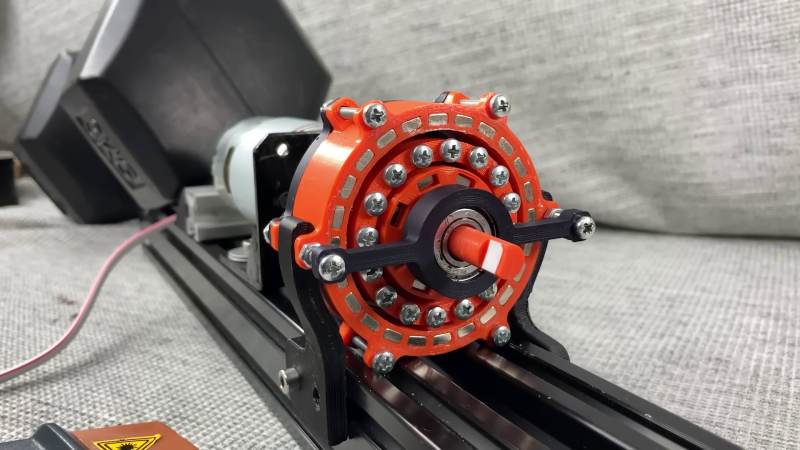3D printed gearboxes are great for experimental designs, but due to roughness and inaccuracies in the printed surfaces, they can wear quickly and be rather noisy. As a possible alternative, [Resetman] is experimenting with magnetic 3D printed gearboxes that work without physical contact between the rotating wheels, and can also be “geared” for different ratios in some interesting ways.
Naturally, two closely spaced wheels with magnets will interact with each other, with the ratio defined by the number of magnets on each wheel. A much less obvious implementation is a second-order radial flux coaxial magnetic gearbox. It works similar to a normal planetary gearbox, with an outer and inner wheel containing magnets, and an intermediate ring known as a flux modulator, containing equally spaced pieces of ferromagnetic steel metal. In [Resetman] demonstration, the flux modulator is just a 3D printed ring screws around its circumference.
The most obvious disadvantage is of course severely limited torque transfer. [Resetman] could easily accelerate the sun wheel to 12,000 RPM if the flux modulator is accelerated slowly, but any sudden changes in speed would cause it to lose synchronization. Of course, you can consider this a torque-limiting feature for certain use cases. With a bit of testing, he determined the torque limit at a 1:4 ratio was a meager 0.05 Nm. This could be increased by some optimization, for example rearranging the magnets to form Halbach arrays, and reducing the air gaps between the components.
Magnetic gearboxes are nothing new, we’ve featured another demonstrator before, and even did an “Ask Hackaday” on the subject. What would you use these for? Let us know below.
















Magnetic coupling’s “killer app’ is manipulation of mechanisms inside a high vacuum vessel.
There has already been and gone a ‘killer app’. Old car / motor bike speedos from the 40’s to the 80’s used a magnetic coupling.
Or anything else to cross a high quality seal against liquids or gases, so long as you use enough magnets to give the levels of torque you do need.
You mean like how there are magnetic stirrers used in labs for decades?
If optimization for their purposes was possible, automotive air conditioner compressors, water pumps, engines/transmissions, basically anything with a shaft seal. Especially if pressure is involved.
Anyone working on magnetic things like this should look up all the info they can find on the Owen Magnetic car.
For a magnetic field to ‘drag’ metal through eddy currents, the magnetic field has to move faster than the metal.
Eddy currents in metal all depend on a magnetic field that is moving relative to the conductor: induction requires a conductive element ‘cut’ through lines of flux.
Bottom line: magnetic clutches and gearboxes will always have more losses than mechanical gearing for the same horsepower.
Even ‘magnet to magnet’ interactions have a induction/eddy current components.
Eddy currents always lead to heating, which is lost energy.
see https://en.wikipedia.org/wiki/Reluctance_motor
While the slip on an asynchronous machine will always be lost (otherwise you have no torque or no asynchronous machine) you can make the rotor anisotropic. Then it can start up asynchronous and switch over to synchronous after the acceleration and so eliminate the slip losses while running at synchronous speed. At this point you have a principally lossless magnetic clutch (may not work for hookers, though :o).
Anisotropic, sounds like the reverse useage of A.B.S., the Anti, Blockage, Break System, of a millenium car. that prohibbetted car tilt-ing with sudden breaks or slipps on dry roads, spinning the car out of control, and with rain, forecome aque plane-ing, wich is a slip on a thinn layer of road water. : Anisotropic, works with timed motor transmission shocks. instead of sudden accelaration, or fliud speed increasment. like a pulse-ating transmissions gearbox. as far as we undersstood it.
That title tho😳
The coolest one is the vacuum tube with moving parts in it. If you ever had an X ray chances are good it was taken with a tube that had a rotating anode.
The youtuber’s name is [Retsetman] Ret-set-man. Please correct to give credit.
Ok, guys who care if it has torch.. can it create electric current? With electric current and storage… Anything else can be done. Duh….